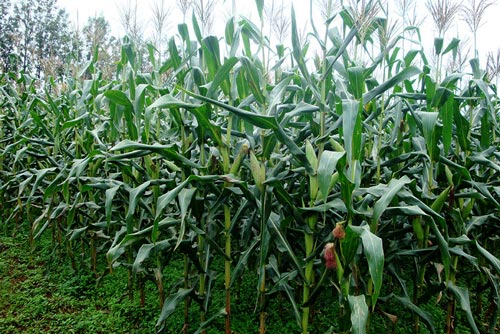The national productivity of maize, one of the most important staple crops grown in Ethiopia, is close to 3 tons/ha, a 50% increase since 2008. This increase is attributed mainly to the use of new technologies, including improved varieties such as the ones developed and provided to smallholder farmers by the Ethiopian Institute of Agricultural Research (EIAR) and CIMMYT. This year, the National Maize Research Program of EIAR in collaboration with CIMMYT released four new varieties for high-potential and drought-prone maize growing areas.
The new varieties include BH546 and BH547, intermediate maturing, three-way cross hybrids released for high-potential maize growing areas, and MH140 and Melkassa-1Q for drought-prone areas. The varieties were either developed from CIMMYT source germplasm or they contain CIMMYT inbred lines as one of their parents. BH546 has a yield advantage of 30% and 10% over BH540 and BH543, the most popular hybrids adapted to the same agro-ecology, with a mean yield potential of 8.7 tons/ha across several locations under optimum management conditions. Its narrow semi-erect leaves make it desirable for high-density planting and inter-cropping with legumes, a common practice in most maize growing areas of the country. BH547 has a grain yield advantage of 26.4% and 7% over BH540 and BH543, respectively, and mean grain yield of 10 tons/ ha. Farmers participating in variety selection preferred the hybrids over the popular varieties for their bigger cob size, good husk cover, high yield potential, and better reaction to known diseases of the area.

MH140, originally developed by CIMMYT-Zimbabwe, is a highly stable high-yielding hybrid tolerant to drought and low nitrogen stresses, as well as major foliar diseases of the central rift valley of Ethiopia. MH140 showed a yield advantage of 18% and 10% over the popular hybrids of the drought prone areas, MH130 and MHQ138, respectively. Melkasa1Q, developed for dry and marginal maize growing areas of Ethiopia, is a quality protein maize version of an extra-early maturing open-pollinated variety Melkasa-1 developed through backcrossing-cum- recurrent selection. The whole grain of Melkasa1Q contains 3.9% lysine and 0.9% tryptophan, about twofold of the levels in Melkassa-1; it shows an 11% grain yield increase over Melkasa-1, with mean grain yield of 4.6 tons/ha.
EIAR in collaboration with CIMMYT and the Ministry of Agriculture have begun variety demonstration and popularization to promote the seed delivery system. Private and public seed companies involved in seed production can take up these varieties and embark on their production and marketing.
EIAR thanks CIMMYT breeders, seed specialists, and project leaders Dagne Wegary, Dan Makumbi, Amsal Tarekegne, Cosmos Magorokosho, Tsedeke Abate, and Mulugeta Mekuria for their technical and financial support leading to the release of the varieties.
 Nutrition, health and food security
Nutrition, health and food security